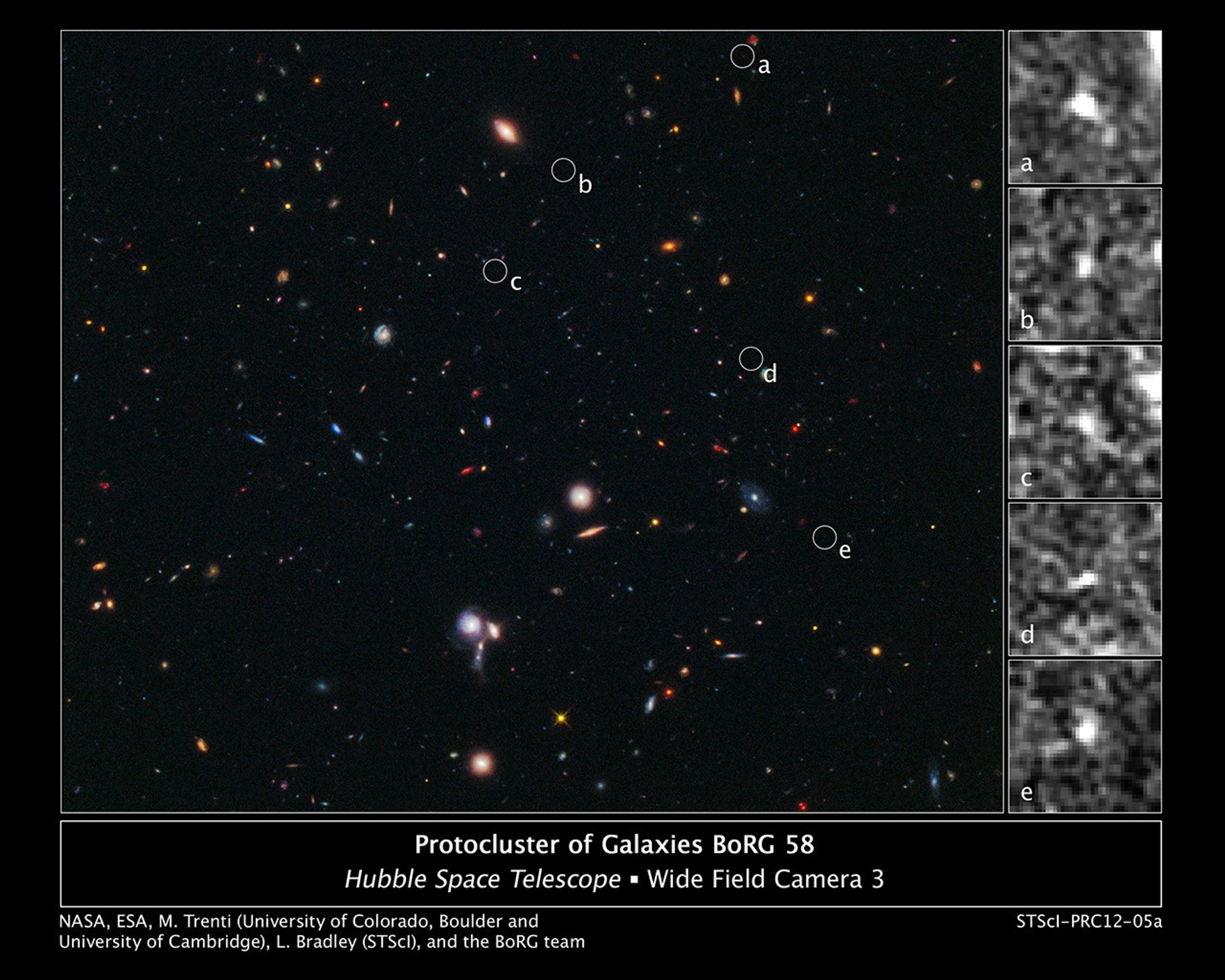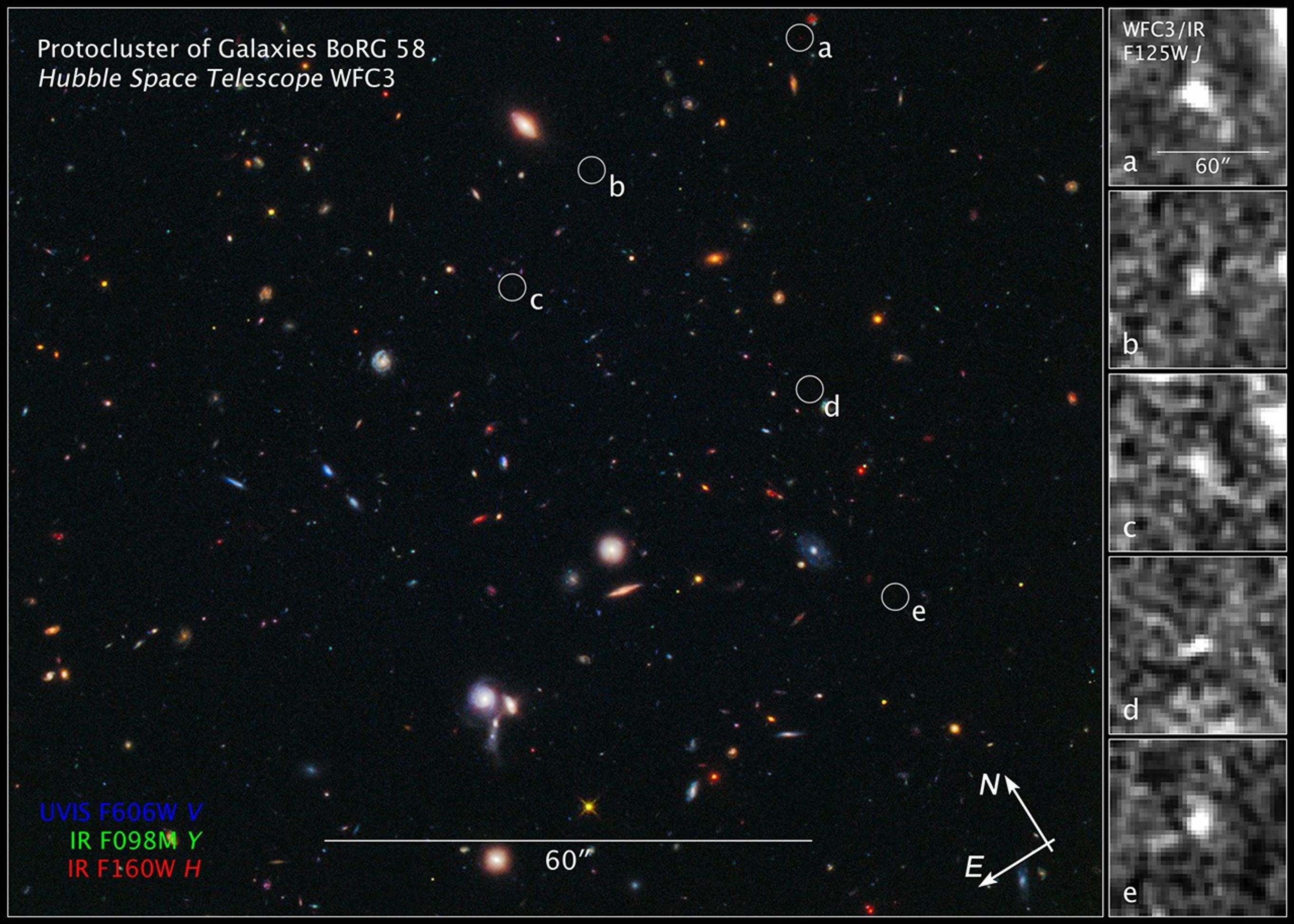1 min read
Hubble Spies Building Blocks of Most Distant Galaxy Cluster

The composite image at left, taken in visible and near-infrared light, reveals the location of five tiny galaxies clustered together 13.1 billion light-years away. The circles pinpoint the galaxies.
The sharp-eyed Wide Field Camera 3 aboard NASA's Hubble Space Telescope spied the galaxies in a random sky survey. The developing cluster is the most distant ever observed. The young galaxies lived just 600 million years after the universe's birth in the big bang.
The average distance between them is comparable to that of the galaxies in the Local Group, consisting of two large spiral galaxies, the Milky Way and Andromeda, and a few dozen small dwarf galaxies.
The close-up images at right, taken in near-infrared light, show the puny galaxies. The letters "a" through "e" correspond to the galaxies' location in the wide-field view at left. Simulations show that the galaxies will eventually merge and form the brightest central galaxy in the cluster, a giant elliptical similar to the Virgo cluster's M87.
Galaxy clusters are the largest structures in the universe, comprising hundreds to thousands of galaxies bound together by gravity. The developing cluster presumably will grow into a massive galactic city, similar in size to the nearby Virgo cluster, a collection of more than 2,000 galaxies.
About the Object
- R.A. PositionR.A. PositionRight ascension – analogous to longitude – is one component of an object's position.14h 36m 55.1s
- Dec. PositionDec. PositionDeclination – analogous to latitude – is one component of an object's position.50° 43' 9.79"
- ConstellationConstellationOne of 88 recognized regions of the celestial sphere in which the object appears.Boötes
- DistanceDistanceThe physical distance from Earth to the astronomical object. Distances within our solar system are usually measured in Astronomical Units (AU). Distances between stars are usually measured in light-years. Interstellar distances can also be measured in parsecs.Redshift: z~8
About the Data
- Data DescriptionData DescriptionProposal: A description of the observations, their scientific justification, and the links to the data available in the science archive.
Science Team: The astronomers who planned the observations and analyzed the data. "PI" refers to the Principal Investigator.These data were from the HST proposal 11700: M. Trenti (University of Colorado, Boulder), M. Stiavelli, J. MacKenty, and M. Mutchler (STScI), and T. Treu (University of California, Santa Barbara). - InstrumentInstrumentThe science instrument used to produce the data.HST>WFC3/UVIS and HST>WFC3/IR
- Exposure DatesExposure DatesThe date(s) that the telescope made its observations and the total exposure time.July 28, 2010, Exposure Time: 2.6 hours
- FiltersFiltersThe camera filters that were used in the science observations.WFC3/UVIS: F606W (V), WFC3/IR: F098M (blue grism), and F160W (H)
- Object NameObject NameA name or catalog number that astronomers use to identify an astronomical object.Galaxies from the Brightest of Reionizing Galaxies (BoRG) Survey, BoRG 58
- Object DescriptionObject DescriptionThe type of astronomical object.Survey Field
- Release DateJanuary 10, 2012
- Science ReleaseHubble Pinpoints Farthest Protocluster of Galaxies Ever Seen
- Credit

This image is a composite of separate exposures acquired by the WFC3 instrument on HST. Several filters were used to sample broad wavelength ranges. The color results from assigning different hues (colors) to each monochromatic (grayscale) image associated with an individual filter. In this case, the assigned colors are: Blue: F606W (V) Green: F098M (blue grism) Red: F160W (H)

Share
Details
Claire Andreoli
NASA’s Goddard Space Flight Center
Greenbelt, Maryland
claire.andreoli@nasa.gov



































